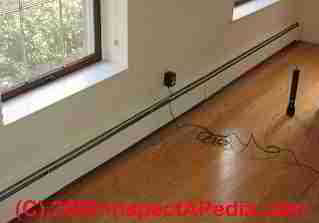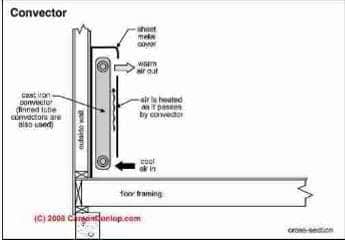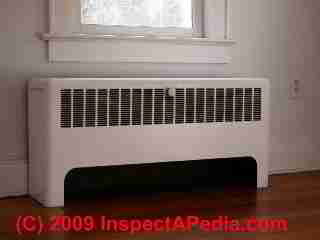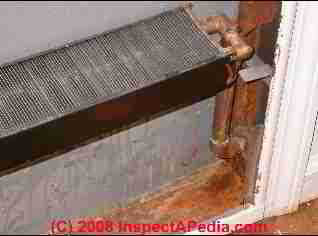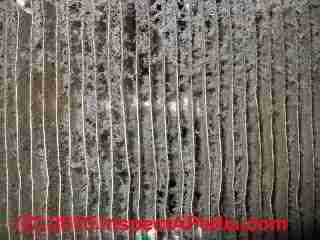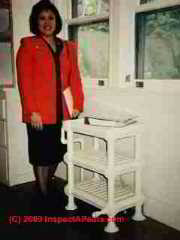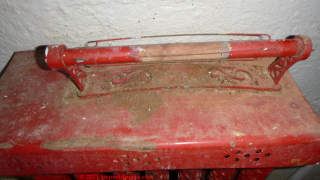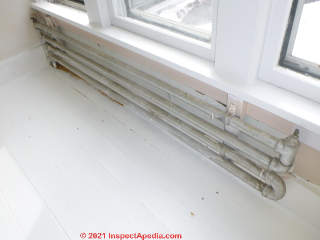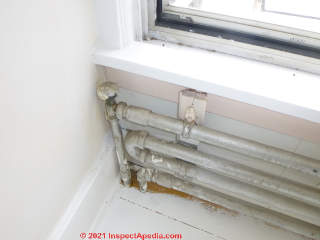 Heating Radiators, Baseboards & Convectors
Heating Radiators, Baseboards & Convectors
Diagnose & Repair Cold Radiators or Baseboards
- POST a QUESTION or COMMENT about troubleshooting heating system radiators, baseboards, convectors - hot water heating systems and steam heating systems
Cold radiator diagnosis & repair home page.
Here is a quick no-heat diagnostic guide for radiators & baseboards.
We also give links to more-detailed heating system diagnostic procedures should you need more help.
Our photo above (at page top) shows a typical "one pipe system" steam cast-iron heating radiator. A single pipe delivers steam to the radiator and condensate from the cooling steam returns to the heating boiler via that same pipe.
InspectAPedia tolerates no conflicts of interest. We have no relationship with advertisers, products, or services discussed at this website.
- Daniel Friedman, Publisher/Editor/Author - See WHO ARE WE?
Fix Hot Water or Steam Radiator, Baseboards, or Convector Unit
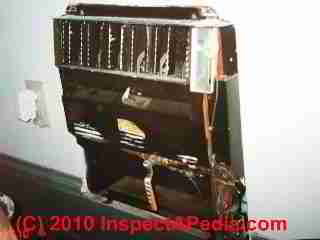 In addition to cast iron radiators using hot water or steam as a heat ource, we describe two other very common hot water heat distribution methods below.
In addition to cast iron radiators using hot water or steam as a heat ource, we describe two other very common hot water heat distribution methods below.
This article series answers most questions about all types of heating systems and gives important inspection, safety, and repair advice.
Below we describe the identification and function of different types of heating output devices in hot water or steam heated buildings.
Photo: an antique in-wall convector radiator.
Article Contents
- COLD RADIATORS? - Quick Fixes
- BASEBOARD HOT WATER HEAT - how it works
- CONVECTOR HEATERS in the wall - how they work, what goes wrong
- UNUSUAL RADIATOR TYPES or SHAPES
- HOT WATER RADIATOR EXPLOSION?
Cold Radiators or Baseboards? - Quick Troubleshooting
Is the heat on?
Make sure that your room thermostat is set to a temperature higher than the temperature in the room - so that it is calling for heat.
Is the heating boiler actually working?
Make sure that your heating boiler is working, that is that the heating boiler turns on and off normally. A hot water heating boiler may not turn on immediately when you turn up the room thermostat: if the water temperature in the boiler is already above the aquastat's cut-in temperature the circulators will send hot water to the radiator and the boiler will turn on later when its temperature is dropped by returning water from the cooler radiators in the building.
Don't forget to check for having run out of heating fuel. If your heating system is not working properly,
see NO HEAT - BOILER.
Are the radiators turned on?
Make sure that the control valve at the heating radiator is "open" or "on".
See RADIATOR VALVES & HEAT CONTROLS.
Are your radiators heated by hot water or steam?
The heating system troubleshooting articles listed just below address nearly all problems with hot water or steam radiators.
If you don't know what kind of heat your building uses, we explain how to figure out the answer
- If your system uses steam heat and a steam radiator is not getting hot,
see STEAM HEAT RADIATOR REPAIR and see STEAM VENTS. - If your system uses hot water heat and a hot water radiator is not getting hot,
see COLD HEATING RADIATOR REPAIR (hot water / hydronic heat) .
If your heating baseboards are not in fact getting warm when your thermostat is calling for heat and the boiler is indeed running, also
see AIRBOUND HEAT SYSTEM REPAIR by WATER FEED VALVE.
You may also need to
see AIR BLEEDER VALVES. - Noisy radiators or heating pipes?
see BANGING HEATING PIPES RADIATORS
How Does Heating Baseboard Work?
Hot water heating baseboard is warmed by hot water circulating through either finned copper tubing or through cast iron baseboard sections. Carson Dunlop Associates' sketch (below left) and our photo of a heating baseboard (below-right) show a typical modern hot water heating baseboard system installation.
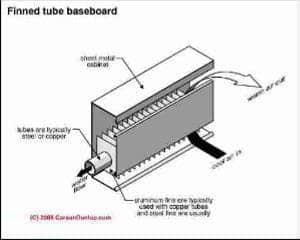
Heating baseboard warms the room by a combination of radiation (the hot baseboard radiates heat onto surfaces in the room) and convection (cool air enters at the baseboard bottom, is warmed, and exits at the baseboard top - see Carson Dunlop Associates 's baseboard sketch above left).
Electric heating baseboard also warms by radiation and convection but the baseboard itself is heated by an electric element rather than hot water.
- Hot water baseboard details: details about inspecting, installing, diagnosing, or repairing baseboard heat are
at BASEBOARD HEAT REPAIR. - Electric baseboard heat details: details about electric baseboard heat are
at ELECTRIC HEAT.
Heating Convector or Wall Convectors
How Do Heating Convectors Work?
Sketch of a wall convector (above left) courtesy of Carson Dunlop Associates and our photo (above right) show a traditional wall-mounted heating convector unit.
Our photo above was taken in a 1920's home in New York. A heating convector unit operates much like a radiator (page top photo) but instead of thick cast iron used to radiate heat, the convector is made of copper tubing covered with metal fins, or of cast iron with cast-in fins.
Our photo below shows a leaky heating convector that was recessed into the wall. While recessed heating convectors were popular for aesthetic reasons (no radiator projects into the room), often a high percentage of the heat is flowing through the exterior wall to outside.
We discuss this problem in more detail
at RADIATOR BASEBOARD or CONVECTOR COVERS.

The heat source in a wall-convector may be forced hot water, gravity hot water, steam, or the unit may be heated by electricity.
Electric-heated wall convectors and some other convector units may incorporate a blower fan to increase the heat output from the device. Our photographs of a wall-mounted heating convector (above) show a wall unit that is heated by steam.
Conventional wall-mounted heating convectors (units that do not include a fan or blower) rely on natural movement of warm-air upwards to draw cooler air in from the floor level. You'll notice that there is a very generous air intake space along the bottom of the convector - it is designed to move plenty of air across its heating coil.
As the convector gets hot, cool air is drawn up from floor level, is heated by the fins on the convector, and warm air is supplied out of the convector's front grille.
Details about wall convectors used for heating or cooling and about convector blower fans are found
and also at FAN COIL & FAN CONVECTOR HEATERS & HYDRONIC COILS
Fan-Driven Heating Convector Units
Electrically-heated, steam heated, or hot water heated fan convector heating units similar to what you see in our photo here but boosted by a fan that blows room air across the heater are discussed
at FAN CONVECTOR HEATERS - HYDRONIC COILS.
Also see RADIANT HEAT.
Wall Heating Convector Heater Maintenance
Once every year or so, we like to take the covers off of heating convectors to inspect the unit for leaks.
While we're at it, we make certain that the heat exchanging fins on the heating convector are not dust-clogged (photo at left). If your building is occupied by pets who shed much hair this step can be very important.
Getting good air flow through the heat exchanging fins of all finned heat exchanging devices such as heating convectors or finned copper tubing heating baseboards can make a significant difference in liberating the heat output from the device.
Just gently vacuum off the convector using a brush attachment and your vacuum cleaner - take care not to bend the fins. A heating service contractor can provide more aggressive cleaning using special products, but on residential heating equipment that has not been exposed to some unusual problem we usually don't find it necessary.
Also see FAN COIL & FAN CONVECTOR HEATERS & HYDRONIC COILS for additional details.
What are These Unfamiliar, Weird-Shaped or Oddly-Located Heating Radiators?
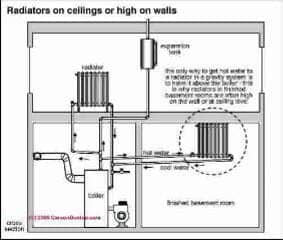
If you are wondering why a cast iron radiator is found mounted high on a building wall or even on a ceiling, the explanation may be found in the sketch (above left) from Carson Dunlop Associates, a Toronto home inspection, education & report writing tool company [ carsondunlop.com ].
Ancillary uses of hot water & steam radiators: plate warmers, towel warmers, robe warmers.
For buildings in which hot water circulated through the heating distribution system by gravity - that is, without using the forced hot water provided by a circulator pump - the only way we could get hot water to rise into a heating radiator was to be certain that the radiator was physically located higher than the top of the heating boiler.
If you find a shelf-like cast iron radiator like the one shown in our photo (above) where it is being admired by a red-jacketed realtor the radiator will probably located in the kitchen or pantry of an older home where it performed double duty as a plate warmer.
The cast iron radiator in our photo, with its three flat shelves, was serving dual-duty as a both a heat source and as a plate warmer for plates coming out of a chilly pantry or dish closet.
Below: this towel rack mounted above a radiator is one of many towel warmer designs that have been popular at both hot water and steam radiators for over a century. Photo courtesy of home inspector Lawrence Transue, cited below.
Antique, Site-Built Pipe Radiators
Home Inspector Lawrence Transue has kindly shared these photos of an antique DIY hydronic heat radiator that he describes below.
Made with 1 1/4 " Pipes and fittings. Make your own radiator. Hot water system 120 year old, west Milford, NJ.
Notice that a conventional air bleeder is installed at the right-hand uppermost tee in this pipe-radiator, and that the control valve is installed at its opposite end [below].
- Lawrence Transue is a Pennsylvania building scientist and consultant, a certified ASHI home inspector, a Licensed Pesticide Applicator, a
BPI Building Analyst & Envelope Professional, with
18 Years of Home Inspection Experience. He can be reached by Telephone: 610.417.0763, by Email: lawrence@lawrencetransue.com as well as at his WEBSITE and at FACEBOOK.
Mr. Transue is a frequent contributor to InspectAPedia.com. - CAST IRON RADIATOR ASSEMBLY INSTRUCTIONS [PDF] Heatline Cast Iron Radiators, U.K.
Hot water heat radiator exploded: what's going on?
Heather said:
I have a boiler for heat in my home with two circulator pumps that supply two different zones (upstairs and downstairs).
My circulator pump for the first floor went bad and was replaced, fixing the problem. The boiler itself had no issues.
An hour later, a radiator upstairs (different zone supplied by the other circulator pump) exploded and a 6 inch piece of metal was cast from the radiator causing water to flood the house.
This happened in a different zone connected to the other pump from the same boiler.
Could the exploded radiator in the other zone have been affected by the replacement of the circulator pump to the other zone?
I cant understand how this coincidentally happened when there seemed to be no problems with the supply to the zone on the second floor where it happened. Any feedback is appreciated. - 1/30/2014
Reply:
Heather,
This sounds horrible - and peculiar. Forensic investigators start by disbelieving coincidences.
But it's not clear why a radiator would explode under any circumstances. Really "explode" ? We're talking about hot water heat, at normal pressures under 30 PSI.
Watch out: if your heating system pressures were abnormally high (over 30 psi) then either your system was missing a critical safety device - a Temperature/pressure relief valve at the boiler - or the valve was installed but was jammed, or subverted, or not working.
IF that is is the case this is a VERY DANGEROUS condition as an exploding boiler can cause a BLEVE explosion of tremendous force.
See details at BLEVE EXPLOSIONS.
In short, a normal hot water heating circulator pump does not have great pumping power; if there was an overpressure problem in the system it seems more likely it came from another component. Naturally everbody involved in working on your system will be scared to admit fault.
Focus on a thorough inspection of the heating boiler starting with
The location, type and condition of pressure/temperature relief valve - see
The normal operating pressure and temperature of the boiler - see
If on your own, before the heating company shows up, if you see high pressure readings on the boiler gauge (30 psi or above) or if you see water spilling out of a relief valve
I would SHUT OFF THE SYSTEM immediately and would get the heck out of there.
...
Reader Comments, Questions & Answers About The Article Above
Below you will find questions and answers previously posted on this page at its page bottom reader comment box.
Reader Q&A - also see RECOMMENDED ARTICLES & FAQs
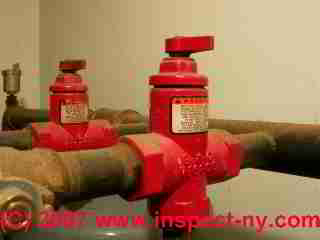 Baseboard Heater Won't Turn Off
Baseboard Heater Won't Turn Off
My runtal baseboard heater will not turn off. We have tried the control at the end of the unit.
(There is only one.) All the others throughout the house are fine. Any suggestions? - On 2020-10-05 by jessica fullerton
Reply by (mod) - heating baseboard won't turn off
Jessica
That sounds like a job for a heating service technician. Is possible that a flow-control valve like the red B&G Flow controllers shown here and that is supposed to prevent out water from circulating through zone when heat is not called for has in fact gotten stuck open.
Details are at CHECK VALVES, HEATING SYSTEM
More causes of heat that won't turn off are explained and repair advice given
Radiator leaks and doesn't get hot
I work at a hospital, we have a heating unit that is about 5' wide X 2' tall. It has a water pipe coming in and returning through 'fins'. the fins the pipes run through are about 3.75" deep and tall. it is not your average or text book radiator heater and would not even call it that but, in the summer, it constantly leaks.
I have taken the covers off and looked for any information (company, model, serial) and have found no identifying marks. the unit may have been here since the mid 50's. It leaks constantly but only during the summer.
I don't know what type of heater it is or how to stop the leaking but it's in our wound care exam room so really need to know how to identify it. - On 2020-06-23 by Brian Bailey -
Reply by (mod) -
Brian
This sounds like a vertical version of a common heating convector that uses hot water and air circulation.
We show photos of heating (and cooling) convector units (mostly wall units) at
https://inspectapedia.com/heat/Wall_Convectors_HVAC.php WALL CONVECTORS HVAC
Please post a photo (one photo per comment) of your heater so that I can take a look.
Often the leak is at an air bleeder or air eliminator that can simply be replaced; you'd need to remove the covers to inspect for and identify the leak.
AIR ELIMINATOR / FLOAT VENT REPLACEMENT shows me replacing an air bleeder on a convector unit
also see
LEAKS at BASEBOARD, CONVECTOR, RADIATOR
and
BASEBOARD, CONVECTOR, RADIATOR TYPES inspectapedia.com/heat/Baseboard_Heat.php
may help you identify types of heating radiators, baseboards, convectors
Upstairs radiators don't get hot
Our sender is constantly running, but not sending hot water to the second floor radiators.
We did bleed a few of them on the second floor we thought it was air in them, but that didn't help. Anyone have any suggestions? - On 2020-03-09 by Lou Ann -
Reply by (mod) -
Lou Ann
It's possible that your circulator pump itself is defective and needs repair or replacement, but the most-common cause of the trouble you describe is air-bound radiators OR air anywhere in the hot water heating piping.
You've tried bleeding air but you may not realize there are other airbound sections of heat piping.
See the diagnostic and repair steps starting at AIR-BOUND HEATING SYSTEMS
We need to reconnect radiators and don't know which side is the inlet
During renovation of our home, we removed the hot water radiators to allow for painting and repairs.
Now we would like to reconnect them, but are unsure which side is the inlet and which is the return. One side has a single opening at the bottom and the other side has an opening at the bottom and an air valve at the top. - On 2017-07-27 by smdkrd -
Reply by (mod) -
SM
Usually the inlet side of the radiator is the side opposite the air vent.
There are plenty of tips to avoid big trouble when installing cast iron radiators, ranging from avoiding a hernia to proper slope to proper fittings and noting the thread directions. Here is a useful tip from Paladin Radiators:
t should not normally be necessary to unscrew the bushes, but if for any reason you do, retighten them gently, enough only to create a good seal. We do not recommend the use of an 18” Stilson. The torque from an 8” adjustable spanner is more than enough to create a good seal.The male thread on each bush on the bleed valve side of the radiator is left hand thread i.e. turn anticlockwise to unscrew. This is the thread that screws into the radiator casting. The female threads on the bushes on the bleed valve side of the radiator are normal right hand thread.
This is the thread that the inlet or outlet valve or bleed valve screws into. The threads on the opposite side of the bleed valve are all normal right hand thread.
- Paladin Radiators Langrick Road New York Lincolnshire LN4 4XH UK Tel: 01205 280354, retrieved 2017 07 27, original source: http://www.paladinradiators.com/guidance/
Not getting enough heat out of a convector radiator
I have convector type radiators in my nyc co-op. I am renovating my 2 bathrooms. In the first 1, I recessed the radiator and added a custom perforated grille with an all over pattern.
For the second bathroom, i was thinking of having the the custom grille have two areas of perforations, one on the top and one on the bottom to try to increase airflow out the top part of the grille.
The grille needs to be removable to access the plumbing, last one was attached with 4 screws.
Inside was insulated with rolled metal of some type, but after the perf grille was added I felt there was less heat output. let me know if changing the design to two areas of perforation would help. thanks! (I can provide photos) - On 2017-04-22 by debgeenyc -
Replyby (mod) -
For sure recessing a radiator and covering it will reduce the heat output to the room. Increasing air inlet and outlet areas can help. You might consider a fan-operated convector if you can fit one in and have power nearby.
Cast iron radiator makes waterfall noises
why is this cast iron radiator sounding like a waterfall when it's cold even when all the air is purged and get straight water from it?
i thought that i could add a picture of it to this question so you could see the piping,but i was wrong.anyway the system is up to pressure at 12-15 psi cold.this is a hot water boiler.
it's a small radiator and the pipes are connected at one end only,one pipe to top and one pipe at bottom with bleeder at opposite end..
.i believe that maybe jacking up cold pressure a bit not to over pressurize might work or that the piping is wrong and should only be piped in from either the tops or bottoms on opposite ends..what solves this problem and how many ways can a radiator be hooked up?thank you. - On 2016-01-30 by mikerosco2004@yahoo.com -
Reply by (mod) -
Mike,
I'm not sure, but perhaps there is a problem with rust or debris in the radiator, OR there is air in the hot water being circulated through the radiator. Be sure that your system has been bled of air in the heating lines and boiler.
Second floor radiators hot, first floor radiators cold
Radiators are hot on second floor on first floor radiators are cold what do I do - On 2016-01-19 by ALEX -
Reply by (mod) -
Alex
See COLD HEATING RADIATOR REPAIR (hot water / hydronic heat) to see diagnosis and repair articles for either hot water heat or steam heat in two separate article
...
Continue reading at ANTIFREEZE for BOILERS or select a topic from the closely-related articles below, or see the complete ARTICLE INDEX.
Or see RADIATOR REPAIR FAQs for help diagnosing & repairing all types of radiators & baseboards.
Or see these
Heating Radiator Articles
- RADIATORS for ROOM HEAT - home
- AIR BLEEDER VALVES
- AIR-BOUND HEATING SYSTEMS - home
- BANGING HEATING PIPES RADIATORS
- BASEBOARD HEAT REPAIR - diagnose & repair
- BASEBOARD, CONVECTOR, RADIATOR TYPES
- BOILER CONTROLS & SWITCHES
- COLD HEATING RADIATOR REPAIR (hot water / hydronic heat) - diagnose & repair
- STEAM HEAT RADIATOR REPAIR - diagnose & repair
- DIAGNOSE & FIX HEATING PROBLEMS-BOILER
- ELECTRIC BASEBOARD HEAT
- EXPANSION TANKS
- EXPLODING RADIATOR
- LEAKS at BASEBOARD, CONVECTOR, RADIATOR
- NOISE, HEATING SYSTEMS
- PLUMBING SYSTEM NOISE DIAGNOSIS & CURE - home
- RADIATOR BASEBOARD or CONVECTOR COVERS
- RADIATOR or CONVECTOR INSULATION
- RADIATOR VALVES & HEAT CONTROLS
- RADIATOR VOLUME & BTUs
- STEAM RADIATOR PIPING CONNECTIONS
- RADIATOR STEAM VENTS - home
- UNEVEN HEAT DIAGNOSIS
- STEAM HEATING SYSTEMS & CONTROLS - home
- UNEVEN HEAT DIAGNOSIS
- WINTERIZE A BUILDING - home
Suggested citation for this web page
RADIATORS for ROOM HEAT at InspectApedia.com - online encyclopedia of building & environmental inspection, testing, diagnosis, repair, & problem prevention advice.
Or see this
INDEX to RELATED ARTICLES: ARTICLE INDEX to HEATING RADIATORS
Or use the SEARCH BOX found below to Ask a Question or Search InspectApedia
Ask a Question or Search InspectApedia
Try the search box just below, or if you prefer, post a question or comment in the Comments box below and we will respond promptly.
Search the InspectApedia website
Note: appearance of your Comment below may be delayed: if your comment contains an image, photograph, web link, or text that looks to the software as if it might be a web link, your posting will appear after it has been approved by a moderator. Apologies for the delay.
Only one image can be added per comment but you can post as many comments, and therefore images, as you like.
You will not receive a notification when a response to your question has been posted.
Please bookmark this page to make it easy for you to check back for our response.
IF above you see "Comment Form is loading comments..." then COMMENT BOX - countable.ca / bawkbox.com IS NOT WORKING.
In any case you are welcome to send an email directly to us at InspectApedia.com at editor@inspectApedia.com
We'll reply to you directly. Please help us help you by noting, in your email, the URL of the InspectApedia page where you wanted to comment.
Citations & References
In addition to any citations in the article above, a full list is available on request.
- Mark Cramer Inspection Services Mark Cramer, Tampa Florida, Mr. Cramer is a past president of ASHI, the American Society of Home Inspectors and is a Florida home inspector and home inspection educator. Mr. Cramer serves on the ASHI Home Inspection Standards. Contact Mark Cramer at: 727-595-4211 mark@BestTampaInspector.com
- John Cranor [Website: /www.house-whisperer.com ] is an ASHI member and a home inspector (The House Whisperer) is located in Glen Allen, VA 23060. He is also a contributor to InspectApedia.com in several technical areas such as plumbing and appliances (dryer vents). Contact Mr. Cranor at 804-873-8534 or by Email: johncranor@verizon.net
- The Steam Book, 1984, Training and Education Department, Fluid Handling Division, ITT [probably out of print, possibly available from several home inspection supply companies] Fuel Oil and Oil Heat Magazine, October 1990, offers an update, (see next item in this list). ITT Fluid Technology, 1133 Westchester Avenue
White Plains, NY 10604, tel +1 914 304 1700 fax +1 914 696 2950 ittfluidbusiness.com - Principles of Steam Heating, $13.25 includes postage. Fuel oil & Oil Heat Magazine, 389 Passaic Ave., Fairfield, NJ 07004.
- The Lost Art of Steam Heating, Dan Holohan, 516-579-3046 FAX
- Principles of Steam Heating, Dan Holohan, technical editor of Fuel Oil and Oil Heat magazine, 389 Passaic Ave., Fairfield, NJ 07004 ($12.+1.25 postage/handling).
- "Residential Steam Heating Systems", Instructional Technologies Institute, Inc., 145 "D" Grassy Plain St., Bethel, CT 06801 800/227-1663 [home inspection training material] 1987
- The Heat Efficiency of Steam Boilers, Bryan Donkin
- Steam Boiler Operation, Principles & Practice, James J. Jackson
- National Fuel Gas Code (Z223.1) $16.00 and National Fuel Gas Code Handbook (Z223.2) $47.00 American Gas Association (A.G.A.), 1515 Wilson Boulevard, Arlington, VA 22209 also available from National Fire Protection Association, Batterymarch Park, Quincy, MA 02269. Fundamentals of Gas Appliance Venting and Ventilation, 1985, American Gas Association Laboratories, Engineering Services Department. American Gas Association, 1515 Wilson Boulevard, Arlington, VA 22209. Catalog #XHO585. Reprinted 1989.
- The Steam Book, 1984, Training and Education Department, Fluid Handling Division, ITT [probably out of print, possibly available from several home inspection supply companies] Fuel Oil and Oil Heat Magazine, October 1990, offers an update,
- Principles of Steam Heating, $13.25 includes postage. Fuel oil & Oil Heat Magazine, 389 Passaic Ave., Fairfield, NJ 07004.
- The Lost Art of Steam Heating, Dan Holohan, 516-579-3046 FAX
- Principles of Steam Heating, Dan Holohan, technical editor of Fuel Oil and Oil Heat magazine, 389 Passaic Ave., Fairfield, NJ 07004 ($12.+1.25 postage/handling).
- "Residential Steam Heating Systems", Instructional Technologies Institute, Inc., 145 "D" Grassy Plain St., Bethel, CT 06801 800/227-1663 [home inspection training material] 1987
- "Residential Hydronic (circulating hot water) Heating Systems", Instructional Technologies Institute, Inc., 145 "D" Grassy Plain St., Bethel, CT 06801 800/227-1663 [home inspection training material] 1987
- Heating, Ventilating, and Air Conditioning Volume I, Heating Fundamentals,
- Boilers, Boiler Conversions, James E. Brumbaugh, ISBN 0-672-23389-4 (v. 1) Volume II, Oil, Gas, and Coal Burners, Controls, Ducts, Piping, Valves, James E. Brumbaugh, ISBN 0-672-23390-7 (v. 2) Volume III, Radiant Heating, Water Heaters, Ventilation, Air Conditioning, Heat Pumps, Air Cleaners, James E. Brumbaugh, ISBN 0-672-23383-5 (v. 3) or ISBN 0-672-23380-0 (set) Special Sales Director, Macmillan Publishing Co., 866 Third Ave., New York, NY 10022. Macmillan Publishing Co., NY
- Installation Guide for Residential Hydronic Heating Systems
- Installation Guide #200, The Hydronics Institute, 35 Russo Place, Berkeley Heights, NJ 07922
- In addition to citations & references found in this article, see the research citations given at the end of the related articles found at our suggested
CONTINUE READING or RECOMMENDED ARTICLES.
- Carson, Dunlop & Associates Ltd., 120 Carlton Street Suite 407, Toronto ON M5A 4K2. Tel: (416) 964-9415 1-800-268-7070 Email: info@carsondunlop.com. Alan Carson is a past president of ASHI, the American Society of Home Inspectors.
Thanks to Alan Carson and Bob Dunlop, for permission for InspectAPedia to use text excerpts from The HOME REFERENCE BOOK - the Encyclopedia of Homes and to use illustrations from The ILLUSTRATED HOME .
Carson Dunlop Associates provides extensive home inspection education and report writing material. In gratitude we provide links to tsome Carson Dunlop Associates products and services.


